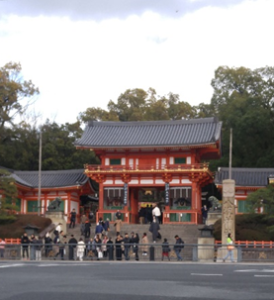Visiting a shrine…is it actually three bows, three claps, and one bow? Origin of triangular rice balls
Yoshie Doi

Yasaka Shrine |

Rice ball and Dashimaki eggs |
The cherry blossom season finally begins to bloom in April, and many tourists visit Kyoto to admire the beautiful scenery. And there are many people who want to go to power spots along with cherry blossom viewing.
Cherry blossom viewing is associated with a cherry blossom viewing bento, but many people also bring rice balls. The triangular shape of the rice ball comes from the “Musubi” of Takamimusu Hinokami and Kamimusu Hinokami. I learned that it is triangular because it means connecting with God.
Kadomatsu, which is displayed during the New Year, is also represented by a bundle of three bamboos. Nowadays, when visiting a shrine, it is common to bow twice, clap twice, and bow once. At some shrines, such as Izumo Taisha, it is “two bows, four claps, one bow”, but I have heard that in many shrines, “two bows, two claps, one bow” is the etiquette.
On the other hand, there is a theory that says “three bows, three claps, one bow” is the correct etiquette. Some people say that three bows and three claps is the true way of worshiping, as it is performed toward the first three gods that appear in the Kojiki. In Japan before the Meiji period, it was common sense to say “three bows, three claps, one bow”. The reason is that the indivisible number three has a meaning.
The three gods are Ame no Minakanushi, Takamimusu Hinokami, and Kamimusu Hinokami, and the number three is important. It is also said that the approach leads to the three paths.
”Two bows, two claps, one bow” was originally an etiquette of the Shinto priests, and was associated with the act of offering tamagushi (Tamagushihoten). Three claps open the divine world, while two claps close it, so it is not transmitted to the gods. There is also a theory that this is preventing the “awakening of the Japanese people.”
”Two bows, two claps, one bow” was actually associated with the “Shinto Restoration Movement” when the new Meiji government took over, and it was written as “two bows, two claps, one bow” in the “Shinto Shrine Ceremony Etiquette” compiled by the Ministry of Home Affairs in 1945. , it seems to have become popular.
The number “three” has been treated as a sacred number since ancient times. Numbers also had meanings, such as the three pillars called the Sankijin, the three beats, and the 339-degree cup. There is a theory that after the war GHQ changed it to two bows, two claps, and one bow, but what is your etiquette when visiting the shrine?
The end of document
Translated by Masami Otani
